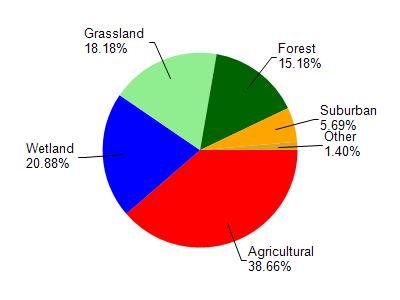Kewaunee
No
No
No
Fish and Aquatic Life
Overview
Red River Swamp, in the Red River and Sturgeon Bay watershed, is a 6.81 acre lake that falls in Kewaunee county. This lake is managed for fishing and swimming and is currently not considered impaired.
Date 2011
Author Aquatic Biologist
Historical Description
Source: 1966, Surface Water Resources of Kewaunee County Red River Swamp, T25N, R23E, Section 11 Surface Acres = 7.7, S.D.F. = 1.47, Maximum Depth = 3 feet A small shallow lake drained intermittently by the Red River to Green Bay. The water is brown, and of high alkalinity. Over 820 acres of cedar-alder swamp constitute the adjoining lands, and enhance its aesthetic value. Winterkill occurs annually. This is a wilderness lake without public access. Waterfowl make only limited use of the area.
Date 1966
Author Surface Water Inventory Of Wisconsin
Condition
Wisconsin has over 84,000 miles of streams, 15,000 lakes and milllions of acres of wetlands. Assessing the condition of this vast amount of water is challenging. The state's water monitoring program uses a media-based, cross-program approach to analyze water condition. An updated monitoring strategy (2015-2020) is now available. Compliance with Clean Water Act fishable, swimmable standards are located in the Executive Summary of Water Condition in 2018. See also the 'monitoring and projects' tab.
Recommendations
Lake Classification
Kewaunee County proposes to conduct a county-wide inventory, analysis and classification of its surface water resources with the intent to develop a comprehensive land use and resource protection plan. This grant will go to aid in the development of that plan that pertains to the Krohn's and Three Mile/Alaska Lakes and watersheds and will address ordinance concerns specific to the needs of those lake resources. A public involvement and education program will be developed and accompany project development.
Management Goals
Wisconsin's Water Quality Standards provide qualitative and quantitative goals for waters that are protective of Fishable, Swimmable conditions [Learn more]. Waters that do not meet water quality standards are considered impaired and restoration actions are planned and carried out until the water is once again fishable and swimmable
Management goals can include creation or implementation of a Total Maximum Daily Load analysis, a Nine Key Element Plan, or other restoration work, education and outreach and more. If specific recommendations exist for this water, they will be displayed below online.
Monitoring
Monitoring the condition of a river, stream, or lake includes gathering physical, chemical, biological, and habitat data. Comprehensive studies often gather all these parameters in great detail, while lighter assessment events will involve sampling physical, chemical and biological data such as macroinvertebrates. Aquatic macroinvertebrates and fish communities integrate watershed or catchment condition, providing great insight into overall ecosystem health. Chemical and habitat parameters tell researchers more about human induced problems including contaminated runoff, point source dischargers, or habitat issues that foster or limit the potential of aquatic communities to thrive in a given area. Wisconsin's Water Monitoring Strategy was recenty updated.
Grants and Management Projects
Monitoring Projects
| WBIC | Official Waterbody Name | Station ID | Station Name | Earliest Fieldwork Date | Latest Fieldwork Date | View Station | View Data |
|---|
| 101100 | Little Mud Lake | 100209 | Little Mud Lake | 9/17/2003 | 9/7/2011 | Map | Data |
|

Watershed Characteristics
Little Mud Lake is located in the Red River and Sturgeon Bay watershed which is 139.16 mi². Land use in the watershed is primarily agricultural (38.70%), wetland (20.90%) and a mix of grassland (18.20%) and other uses (22.30%). This watershed has 149.91 stream miles, 20,800.31 lake acres and 16,378.27 wetland acres.
Nonpoint Source Characteristics
This watershed is ranked Medium for runoff impacts on streams, Not Ranked for runoff impacts on lakes and High for runoff impacts on groundwater and therefore has an overall rank of High. This value can be used in ranking the watershed or individual waterbodies for grant funding under state and county programs.However, all waters are affected by diffuse pollutant sources regardless of initial water quality. Applications for specific runoff projects under state or county grant programs may be pursued. For more information, go to surface water program grants.